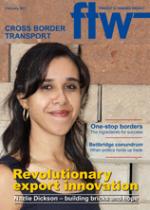Hydraform don’t just cross borders, they
infiltrate communities and create hope in
places where there is sometimes very little
else.
From Bujumbura to Burkina Faso their
achievements stand proud and it is hard to
comprehend that the vision for one of South
Africa’s top medium exporters was born in a
garage in Sunward Park in Boksburg more than
20 years ago.
It would be too simplistic to describe the
company as manufacturers and exporters of
unique brick-making machines. In Zambia an
orphanage is finally self sustaining after buying
one of Hydraform’s block-making machines –
not only do the children now have homes, but
they use the machine to make bricks that they
sell for an income. In Tanzania the Malaika
children’s village is a safe haven to children who
have been left orphaned by HIV/Aids. Built with
Hydraform blocks the village and its adjoining
school is home to more than 300 children. In
Northern Uganda a community – rural and
poor – finally has doors it can close against the
elements, keeping its children safe and warm.
There is no doubt that when it comes to
housing projects, the Hydraform building system
takes into account the three pivotal factors that
ensure success – cost effectiveness, community
upliftment and sustainability.
“The founders of the company, Jochen Kofahl
and Robert Plattner, were not just creating
a business, they had a vision of creating an
alternative building system,” says Hydraform
marketing manager Nazlie Dickson. “They
tell the story of how it all started in a garage in
Boksburg where they spent hours researching
and developing their first brick-making
machine.”
Today Hydraform technology has been used
all over the world with over 3000 Hydraform
block machines running on five continents.
The bricks are fire-resistant, durable and are
thermally, acoustically and structurally beneficial
for housing.
There is a range of machines that can produce
between 1500 and 3000 building blocks a day
that are interlocking. Mortar is only used in the
foundation phase of building and below the roof
structure, but once it gets to ground level blocks
are literally just stacked up to create structures.
“The benefits are endless from its cost
efficiency to its structural soundness,” says
Dickson. “The system is really unique in that
a Hydraform Interlocking building block is
produced from soil found on or near the building
site and mixed with 5-10% cement. Very little
water is used for block-making and no burning
or firing of blocks is required.
Eco-friendly and not needing skilled labour, it
is a system that has been embraced by a diversity
of customers.
“Obviously governments and nongovernmental
organisations are some of our
big clients as the benefits are huge in that the
machine is very mobile, diesel driven and easy
to use.”
But it is also sought after by entrepreneurs
wanting to start their own block yard or
construction company.
The vision has never really changed from
research and development and the company,
originally named after its product – the hydraulic
formation of bricks or blocks – has expanded to
include a vibraform range of machines which
make standard concrete blocks and pavers.
Hydraform also offers a range of entry level roof
tile machines and more recently has stepped into
the solar lighting industry.”
There are three elements that are crucial
for good exporting, she says. While most of
the machines destined for southern Africa are
delivered by road, East and West Africa is
serviced by sea.
“Strategically and logistically it has made
sense to establish our factory in Durban as we
use the port to import certain components and
to export our finished products. Sea remains
the most cost-effective and safe way of moving
cargo although South Africa is still very isolated
in that only a limited number of vessels are
calling between South Africa and other African
ports.”
Dickson believes trade in Africa could greatly
benefit if it was streamlined and allowed to
flow more easily. “Monopolies around routes
make the end product more expensive, while we
also have systems in place that are not always
accommodating for fast and efficient exports.
VAT restrictions are cumbersome to our clients
and often the bureaucracy around the processing
of exports, like the documentation that is needed,
can be difficult to deal with. Then there are
the import taxes on the clients’ end to take into
consideration. Africa trading with Africa should
be made easier to encourage more trade.”
Recently awarded the Gauteng Medium
Exporter of the Year award as well as the winner
of the Exporter into Africa Award, the company
has managed to maintain export sales by not just
providing a good product to its clients but also in
developing skills through training programmes
across the continent.
“For 2011 we see good opportunities and we
hope that the rand/dollar exchange rate becomes
a bit more conducive to benefit South African
exporters,” says Dickson.
Selling brick-making machines and hope for Africa’s communities
04 Feb 2011 - by Liesl Venter
0 Comments
Cross Border Transport 2011

04 Feb 2011
04 Feb 2011
04 Feb 2011
04 Feb 2011
04 Feb 2011
04 Feb 2011
04 Feb 2011
